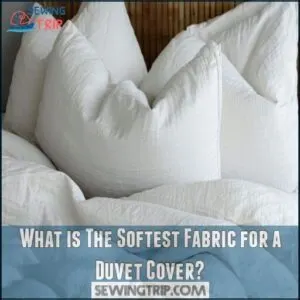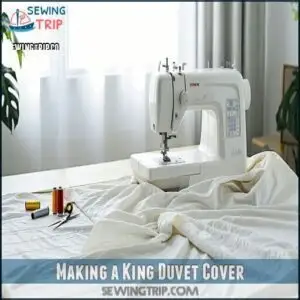This site is supported by our readers. We may earn a commission, at no cost to you, if you purchase through links.
 Making your own duvet cover is easier than you’d think! Grab two flat sheets in your preferred size and fabric—cotton works great for breathability, but softer options like linen or microfiber add a touch of luxury.
Making your own duvet cover is easier than you’d think! Grab two flat sheets in your preferred size and fabric—cotton works great for breathability, but softer options like linen or microfiber add a touch of luxury.
Pin the sheets together, ensuring the patterns or right sides face inward. Sew along three edges with a ½-inch seam allowance, leaving one short side open.
Trim the corners, flip it right-side out, and press with an iron for a neat finish. For extra durability, topstitch the seams or use a serger.
Add snaps, buttons, or a zipper to close it up. With these steps, you’re all set to create bedding that’s both functional and personal!
Table Of Contents
Key Takeaways
- You can easily make a duvet cover using two flat sheets, sewing three sides, and adding closures like buttons, snaps, or a zipper.
- Choosing the right fabric, such as breathable cotton or soft bamboo rayon, ensures comfort and durability for your duvet cover.
- Turning old flat sheets into a duvet cover is a budget-friendly project that customizes your bedding.
- Using corner ties or fabric strips keeps the duvet insert secure and prevents bunching for a snug, neat fit.
How to Make a Duvet Cover
You’ll transform your bedroom with a custom duvet cover that fits your style and budget perfectly.
With just some basic sewing skills and the right measurements, you can create professional-looking bedding that would cost three times as much in stores, which is a great way to achieve custom results.
What is The Best Fabric for Duvet Cover?
When selecting the best fabric for your duvet cover, breathability should top your priority list.
Egyptian cotton offers exceptional durability and softness, while linen provides superior airflow for hot sleepers.
Consider seasonal fabrics—lighter cotton for summer and warmer cotton-linen blends for winter.
Your fabric choices should reflect allergy considerations too; natural materials like cotton reduce dust mite accumulation.
Cost comparison reveals long-staple cotton provides the best value for its longevity.
For sensitive skin, consider organic cotton benefits, which are hypoallergenic.
What is The Softest Fabric for a Duvet Cover?
Your fingertips will melt against bamboo rayon, the cloud-like champion of softness for duvet covers.
Bamboo rayon is pure luxury—soft, silky, and irresistibly cozy for the ultimate duvet cover experience.
It’s even softer than Egyptian cotton! Thread count and weave type matter, but fabric choices like TENCEL lyocell with its buttery-soft texture and microfiber’s irresistible feel are close competitors.
You can even find a bamboo rayon duvet for ultimate comfort.
For natural options, high-quality cotton and linen get softer with each wash, while fabric blends combine comfort with practicality.
Can You Make a Duvet Cover Out of Sheets?
Yes, you can absolutely turn your old sheets into a gorgeous duvet cover. This sheet alternative offers both cost effectiveness and personal style.
Turn your old sheets into a stylish, budget-friendly duvet cover that refreshes your bedroom and showcases your creativity.
- Flat sheets work best – they provide the large surface area needed
- Size matters – use a sheet slightly larger than your comforter for proper fit
- Pattern matching becomes simple with complementary sheet sets
- Breathability comparison favors cotton or linen sheets for comfort
- Durability concerns are minimal when using quality sheets
This easy duvet cover approach saves money while giving your bedroom a fresh look. Plus, it’s a perfect sewing duvet cover project for beginners without specialized materials!
DIY Duvet Cover Ideas
You’ll transform your bedroom with a custom duvet cover that perfectly matches your style and budget.
Whether you’re crafting a cozy single cover or tackling a king-sized project, these straightforward ideas will guide you through the process with professional results.
Making a Single Duvet Cover
Creating a single duvet cover from scratch is both rewarding and practical for your bedding needs. With the right approach, you’ll have a custom cover that fits perfectly.
- Calculate your fabric yardage based on your insert weight and single bed dimensions (typically 39" x 75"), adding 2-3 inches all around for seam allowances.
- Choose lightweight cotton or linen-blend fabrics that breathe well and won’t trap heat against your body during sleep.
- Consider various fastener options like buttons, invisible zippers, or velcro strips along the bottom edge for easy insert removal.
- Implement corner securing techniques using fabric ties or small snaps to prevent the insert from bunching up inside the cover.
Don’t forget about seam finishes – French seams provide a clean, professional look with no raw edges showing. You can find a suitable duvet cover online. For beginners, this duvet cover tutorial offers an easy entry point into sewing bedding that perfectly fits your style preferences and comfort needs.
Making a King Duvet Cover
After mastering a single duvet cover, let’s scale up to a king size project! King duvet covers require specific measurements and techniques for perfect results.
| King Size Specifics | DIY Tips |
|---|---|
| Fabric width: 108" | Use flat sheets as alternative |
| Fabric length: 104" | Add 4" for seam allowance |
| Yardage needs: 10 yards | Consider pattern matching |
| Corner construction | Add ties inside corners |
| Fastener options | Choose buttons or invisible zipper |
You’ll need wider fabric for a king duvet cover tutorial. Cut your panels according to measurements, reinforce seams for durability, and don’t forget those corner ties to keep your insert in place.
For easy maintenance, remember that you can achieve easy maintenance with removable covers. With proper fabric width and length calculations, your DIY king duvet cover will look store-bought!
Tips for Making Your Own Duvet Cover
You’ll save time and frustration with these practical tips that make DIY duvet covers a breeze.
Whether you’re adding fabric ties for secure corner connections or exploring no-sew adhesive options, these techniques will help you create custom bedding that perfectly fits your style and comfort needs, with practical tips.
Using Fabric Ties or Ribbons
Adding fabric ties or ribbon ties to your duvet cover is a simple way to mix functionality with style. This method doesn’t just secure your duvet insert—it brings a touch of creativity to your bedding.
You can experiment with tie placement, choosing evenly spaced pairs or asymmetrical designs for flair. Ribbon embellishments, like bold colors or textured fabrics, make a statement, while decorative knots or bow ties add sophistication.
To create duvet cover ties, cut 6-inch by 18-inch strips of your chosen ribbon material or fabric. Fold each strip in half, sew or secure the edges, then attach six pairs along the open edge of the cover.
When the ties are in place, simply knot them to hold your duvet securely. Need tie alternatives? Try braided fabric strips for added durability. Securing the pocket flap can be done with convenient Velcro strips.
Personalizing tie placement makes every duvet unique, blending style and practicality beautifully.
No-Sew Adhesive Options
Skip the sewing machine and make a no-sew duvet cover using bonding adhesives or adhesive strips.
Fabric glues like Aleene’s Fabric Fusion and fusible tape are perfect for sticking fabrics together. Iron-on adhesives create a strong hold, while adhesive sprays or double-sided tape work for temporary adhesives.
Pair these nosew adhesives with fabric ties for a personalized touch. Some may prefer using a specialized duvet adhesive for enhanced results.
Just verify your materials are lightweight and smooth for better results, and voilà—your custom bedding is ready without a single stitch!
Putting on a Duvet Cover by Yourself
Struggling with putting on a duvet cover by yourself? It’s easier than it seems with these simple duvet cover steps.
Try this:
- Start with the Gravity Method: Turn the duvet cover inside out and lay it flat on your bed, the opening at the foot of the bed.
- Use Corner Securing Techniques: Grab the duvet’s top corners and match them with the cover’s top corners. Tie or secure with corner ties, if available.
- Roll and Insert: Roll the duvet and cover together from the top, moving toward the opening. Flip the cover right-side out as you go.
- Smooth and Adjust: Shake gently, smooth out any lumps, and fold edges neatly.
Master the rolling method—it’s quick and saves frustration!
Frequently Asked Questions (FAQs)
How many yards of fabric do you need for a duvet cover?
To make a duvet cover, you’ll typically need around 6-10 yards of fabric, depending on the bed size.
Measure your duvet insert, add seam allowances, and plan for extra panels if fabric isn’t wide enough, which is a complete concept to consider for the project.
Can you make your own duvet cover?
Absolutely, you can whip up your own duvet cover!
It’s a beginner-friendly sewing project with straight seams, customizable fabrics, and simple techniques.
Just measure, cut, sew, and voilà—your personalized bedding masterpiece is ready!
How to make a single duvet cover?
Cut fabric to fit your duvet, adding seam allowances.
Sew panels together for the top and bottom layers, attach side panels, and finish edges.
Add closures like buttons or zippers, ensuring a snug fit.
How to put on a duvet cover by yourself?
Lay the duvet cover inside out on your bed.
Place the duvet insert on top, then roll them together like a burrito.
Flip the cover over the roll, unroll, and shake everything into place.
Can I use a duvet cover with a comforter?
Think of a duvet cover as a stylish jacket for your comforter.
Yes, you can use it!
Just make certain it matches the comforter size and secures well, so it doesn’t shift or bunch.
How do I wash a duvet cover?
Wash your duvet cover in cold water on a gentle cycle using mild detergent.
Close buttons or zippers to prevent snagging.
Tumble dry on low or air-dry to maintain its shape and fabric quality.
Can I use a flat sheet for a duvet cover?
Why not use a flat sheet for a duvet cover?
It’s a budget-friendly option, already sized close to most duvets.
Just sew edges neatly, add closures like buttons or zippers, and you’re all set!
What is the best fabric for a duvet cover?
Lightweight cotton or cotton-linen blends work best for duvet covers.
They’re breathable, durable, and easy to clean.
Look for wrinkle-resistant options for a neat look, or hypoallergenic fabrics if you’ve got sensitive skin or allergies.
Do I need a special sewing machine?
You don’t need a fancy sewing machine—any standard one will do.
Just make sure it handles straight stitches, zigzag, and durable seams.
A dependable, well-loved machine works just fine for crafting duvet covers!
What tools are needed for sewing a duvet?
To sew a duvet, you’ll need fabric, thread, a sewing machine, scissors, pins, an iron, and a measuring tape.
Optional tools include a zipper, buttons, or snaps for closures, plus a seam ripper.
Conclusion
Creating your own duvet cover is like tailoring a cozy home for your comforter—it’s practical, personal, and surprisingly simple.
Whether you’re using cotton for breathability or opting for softer fabrics like linen, following this tutorialsdiy duvet cover guide guarantees great results.
From choosing fabric to sewing and closures, each step adds functionality and style.
So, grab those flat sheets, tools, and a bit of time, and enjoy the satisfaction of sleeping under something handmade just for you, which is a truly personal experience.













